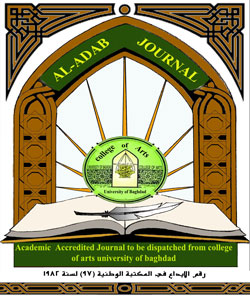An Imagist Reading of William Carlos Williams’ “The Wanderer”
DOI:
https://doi.org/10.31973/aj.v1i148.4232Keywords:
William Carlos Williams, Imagism, The Wanderer, Modernism, Romanticism, American poetryAbstract
This paper examines William Carlos Williams’ “The Wanderer,” one of the earliest poems in his poetic career, in terms of one of the Imagistic tenets that Williams adopted, that is “Direct treatment of the ‘thing’, whether subjective or objective.” Although Williams was highly influenced by Keatsian idealism which appeared in his early works, yet “The Wanderer” presents his attempt of making this romantic ideology as a starting point for his more imagistic approach. The paper follows and investigates the journey of the poet (in the poem) in his flight from the heights of his past romantic wanderings into more local and modernist encounters which he presents as episodes and images. The culmination of this experience leads to a baptism ritual through which the poet announces a new wandering that is would be purely imagist.
Downloads
References
Aji, Hélène. (2005). “Ezra Pound and William Carlos Williams’ Romantic Dilemma’s From Obliteration to Remanence.” Cercles 12: 50-63.
Billitteri, Carla. (2007). “William Carlos Williams and the Politics of Form.” Journal of Modern Literature 30 (2): 42-63
Breslin, James E. (1970). William Carlos Williams: An American Artist. NY: Oxford University Press.
Callan, Ron. (1992). William Carlos Williams and Transcendentalism Fitting the Crab in a Box. NY: Palgrave Macmillan.
Duffey, Bernard I. (1986). A Poetry of Presence: The Writing of William Carlos Williams. Madison: University of Wisconsin Press.
Finkelstein, Norman M. (1983). “Beauty, Truth and the Wanderer.” in William Carlos Williams Man and Poet, edited by Carroll F. Terrell. 233-242. Orono, Me.: National Poetry Foundation, University of Maine at Orono.
Gray, Richard. (1991). American Poetry of Twentieth Century. NY: Longman.
Heyen, William. (1970). "The Poet's Leap into Reality." Saturday Review 53 (1): 21-24.
Lawson, Andrew. (1994). “Divisions of Labour: William Carlos Williams’s ‘The Wanderer’ and the Politics of Modernism.” William Carlos Williams Review 20 (1): 1-22
Mariani, Paul. (1981). William Carlos William: A New Naked World. NY: McGraw-Hill.
Miller, J. Hillis. (1965). Poets of Reality Six Twentieth Writers. Massachusetts: Harvard University Press.
Pickard, Zacharia. (2010). “Description, and the Avant-garde.” American Literary History 22(1): 85-108.
Pound, Ezra. (1913). “A Few Don'ts by an Imagiste.” Poetry 1 (6): 200-206.
Rapp, Carl. (1984). William Carlos Williams and Romantic Idealism. Hanover: Brown University Press.
White, Eric B. (2016). William Carlos Williams and the Local. In The Cambridge Companion to William Carlos Williams, edited by Christopher MacGowan, 8-23. NY: Cambridge University Press.
Williams, Carlos William. (1951). “The Wanderer” in The Collected Earlier Poems of William Carlos Williams. 1-12. NY: New Directions.
Williams, Carlos William. (1937). “A Note on Poetry.” Oxford Anthology of American Literature. Edited by William Rose Benet and Norman Holmes Pearson. Vol.2. NY: Oxford University Press.
Williams, Carlos William. (1951). The Autobiography of William Carlos Williams. NY: Random House.
Williams, Carlos William. (1957). The Selected Letters of William Carlos Williams, edited by John C. Thirlwall. NY: McDowell, Obolensky.
Downloads
Published
Issue
Section
License
Copyright (c) 2024 Assist. Lect. Zahraa Taher Essa

This work is licensed under a Creative Commons Attribution 4.0 International License.
Copyright and Licensing:
For all articles published in Al-Adab journal, copyright is retained by the authors. Articles are licensed under an open access Creative Commons CC BY 4.0 license, meaning that anyone may download and read the paper for free. In addition, the article may be reused and quoted provided that the original published version is cited. These conditions allow for maximum use and exposure of the work.
Reproducing Published Material from other Publishers: It is absolutely essential that authors obtain permission to reproduce any published material (figures, schemes, tables or any extract of a text) which does not fall into the public domain, or for which they do not hold the copyright. Permission should be requested by the authors from the copyrightholder (usually the Publisher, please refer to the imprint of the individual publications to identify the copyrightholder).
Permission is required for: Your own works published by other Publishers and for which you did not retain copyright.
Substantial extracts from anyones' works or a series of works.
Use of Tables, Graphs, Charts, Schemes and Artworks if they are unaltered or slightly modified.
Photographs for which you do not hold copyright.
Permission is not required for: Reconstruction of your own table with data already published elsewhere. Please notice that in this case you must cite the source of the data in the form of either "Data from..." or "Adapted from...".
Reasonably short quotes are considered fair use and therefore do not require permission.
Graphs, Charts, Schemes and Artworks that are completely redrawn by the authors and significantly changed beyond recognition do not require permission.
Obtaining Permission
In order to avoid unnecessary delays in the publication process, you should start obtaining permissions as early as possible. If in any doubt about the copyright, apply for permission. Al-Adab Journal cannot publish material from other publications without permission.
The copyright holder may give you instructions on the form of acknowledgement to be followed; otherwise follow the style: "Reproduced with permission from [author], [book/journal title]; published by [publisher], [year].' at the end of the caption of the Table, Figure or Scheme.











